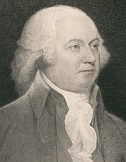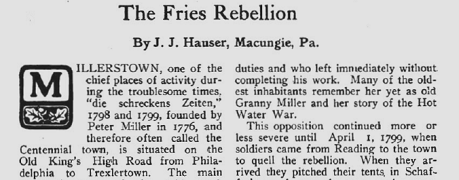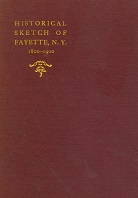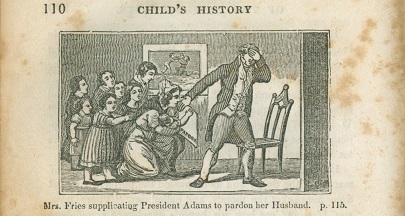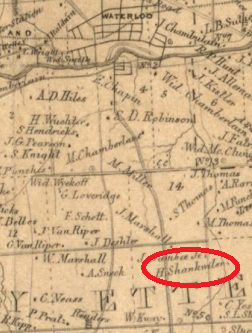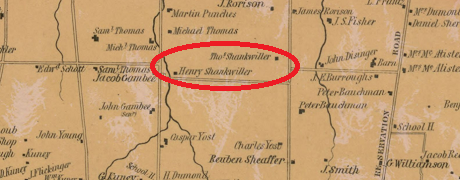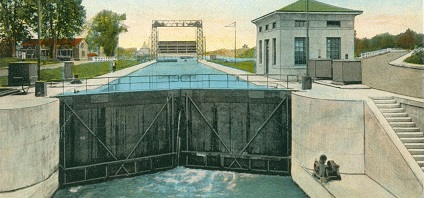
|
Elisabetha (Gaumer) |
Elisabetha (Gaumer) Schanckweiler was born on Sept. 11, 1767 in Macungie Township, Lehigh County, PA, the youngest daughter of Johann "Dietrich" and Maria "Elizabeth" (Meinert) Gaumer Sr. Her husband was an outspoken farmer whose objection to new taxes led to imprisonment at the order of President John Adams.
In about 1792, at the age of 25, she married 21-year-old Heinrich "Henry" Schankweiler (1771-1858), also Americanized to "Shankwiler" and "Shankweiler."
The Schankweilers lived in 1799 in a log house in Macungie, Lehigh (formerly Northampton) County, PA.
They are believed to have borne six children, among them Elizabeth Trexler, Catharina Stout, Anna Shankwiler and James Shankweiler. Also believed to be their sons were Thomas Shankwiler and Henry Shankwiler.
|
|
|
Henry's profile in Centennial Historical Sketch of the Town of Fayette |
At some point, the family relocated across the state line into Fayette, Seneca County, NY.
Sadly, daughter Anna passed away at the age of four and a half on May 8, 1809, with interment in the Jerusalem Cemetery in Fayette Township.
|
|
|
Presidents Adams and Jefferson |
Henry is profiled in the 1890 book Centennial Historical Sketch of the Town of Fayette, Seneca County, New York (Geneva, NY - prepared by Diedrich Willers). In part, his entry reads:
In his early manhood, while a resident of Pennsylvania, as a friend and partizan of Thomas Jefferson, he took an active interest in public affairs, in opposition to the Federal party and the sedition and tax laws of the national congress, which brought upon him for a time the disfavor of the administration of President John Adams in 1800, the seat of the national government, being then still at Philadelphia, Pa. He removed to the Town of Fayette and purchased a fine farm near the center of the town in May, 1813, where he resided until his death. The interest he took in the management of public affairs in his native State, soon induced him in his new home, to familiarize himself with the local government of his town and he was early chosen one of its commissioners of highways and overseer of the poor. In 1823, and again in 1824, he was elected supervisor of Fayette, one of the first of the sturdy Pennsylvania Germans who served the town in that capacity.
Henry's dispute with the Adams Administration took place in March 1799 under what was known at the time as the "Alien and Sedition Acts" signed into law in 1798, commonly known as the "Gag Law" and considered part of the president's "reign of terror." The Acts gave Congress the power to deport immigrants and make it more difficult for them to vote, and to exercise discipline over citizens who would "write, print, utter or publish" comments that the government considered "false, scandalous and malicious."
|
|
|
Article describing Henry's arrest and imprisonment in Philadelphia |
|
|
|
Moravian Sun Inn, Bethlehem, PA |
In March 1799, federal marshals named Nicholas, Eierly, Balliet and Adolph arrested Henry at his home in Millerstown in Macungie Township for comments he had made against a number of pieces of legislation which the Congress had passed but which he believed took away some of his civil liberties. Friends who were in the local militia attempted to rescue Henry and went to Bethlehem to do so. Upon arriving in Bethlehem, they were met by William Henry, who said in German: "Mir wohnen in einem freien land, ich denke mann darf mit seinem gewehr hingehen wo er will wenn er niemond beldidiget." Loosely translated, he said: "I live in a free country, I think a man with his rifle must go where he wants."
Henry responded in German: "Dies gehet gegen die Civil Law, und wenn ihr euer gewehr nicht obleget so wird ihr am galga dafür bueszen." Loosely translated into English, his words meant "This goes against civil law, if your gun does not oblige." The government officials checked their weapons with the Sun Inn proprietor and went inside to drink beer. John Fries from Bucks County, PA, who was leading a more broad armed rebellion against government oppression, arrived on the scene with others, "surrounded the hotel and rescued the prisoners," said the article "The Fries Rebellion," by J.J. Hauser of Macungie, printed in the 1912 book The Penn Germania: A Popular Journal of German History and Ideals in the United States, Vol. 13, by H.W. Kriebel of Lititz, PA (Cleona, PA: Holzapfel Publishing Company). Henry later was tried and convicted and spent a year in jail, paying a fine of $150.
In Henry's own words, he described what happened:
I told Nichols I had spoken against the stamp act, the house tax law, the alien and sedition laws. He informed me I must go with him to Philadelphia or get security for my appearance there at court; I told him I would give security, and agreed to meet him the next or following day with my sureties, at a public house in Bethlehem... I went there according to agreement, with my bail, Jacob Druckenmiller and Conrad Wetsel, government men; for I was told by Nickols [sic] that only such would answer. When I arrived at Bethlehem I found Nichols and also one John Fries, with a Company of riflemen, and many other persons. Nichols asked me why I came there with so many men. I told him that they did not come with me, and that I knew nothing of their meeting. More than twenty persons from different parts of Northampton county were prisoners in an upper room of the publick house, confined there by Nichols upon government process, and as I always understood, for speaking against these laws. They were not able to get bail, and Nichols was about to start for Philadelphia with them. The object of Fries was to prevent the officer, as he said, from driving them there as a drove of cattle. Fries and his men prevented Nichols from taking them to Philadelphia and he left the place, without taking my bail, or doing any thing more with the prisoners. I had nothing to do with Fries, had no arms; and no knowledge of such a meeting until I arrived there.
|
|
|
Historical Sketch book |
Sometime in the latter part of the same month, my friends wrote to me from Philadelphia, that I had better come down and enter into bail upon the arrest made by Nichols, as President Adams was about sending an armed force into my country, to arrest the prisoners who had been released by Fries. I went immediately to Philadelphia, and went before Judge Peters with my bail, John Gouldbach and Thomas Mahoter, both government men. Judge Peters asked me why I talked so much about government. I told him my father and brother had fought for liberty, and that the gag law violated that liberty; that I had a right to speak against it and would. The Judge then rose from his seat apparently angry, and said "the law was made to make you hold your tongue."
The Judge took my bail for my appearance at the May court, 1799. An indictment was found against me at that court for sedition and conspiracy. I was not then tried; my counsel thinking it would be dangerous to risk a trial at that session of the court, as the men in power were too much excited against those who had spoken against government. I then entered into new sureties for my appearance at the fall court in the same year. My trial did not then come on, owing to my sickness. I entered into new bail for the next court, which would be in the spring of 1800. I appeared at that court. -- When the trial of the indictment was called, by the government council, my lawyer informed the court that I was not then ready. The Court gave me two days from that time. I sent for my witnesses, but before the second day arrived the marshal came to me in the street and told me I must go into court. I appeared in court, and without any testimony, was sentenced by Judge Chase, to one year's imprisonment, and the payment of a fine of one hundred and fifty dollars. -- I was put into jail immediately, and remained there until February, 1801, when I was released by President Adams, a few days before he went out of office....
When President Adams sent his army of several thousand
men into Northampton I recollect that among the many outrages committed by them,
they seized and handcuffed an old and respectable inhabitant, John Kyser and
dragged him to Philadelphia because it was said he had been speaking against
government. He was confined there five or six weeks and then released. Daniel
Swartz, a worthy farmer of the same county, was arrested for permitting a young
man, Samuel Doan, to ride one of his horses to Bethlehem, and was convicted for
this alone; and his sentence was eight months imprisonment, and a fine of four
hundred dollars.
|
|
|
"Mrs. Fries
supplicating President Adams to pardon her husband," |
For his role in inciting and supporting the insurgence, Fries had been sentenced to death by hanging. He was said to have been an old man with 10 children, one just a newborn. His friends circulated a petitioned signed by several thousand people, asking President Adams for a pardon. They then gave the document to Fries' wife. Popular history suggests that she traveled to Philadelphia to present it to the president in person, but this is not yet confirmed. What is known is that Adams was merciful in the matter, or politically astute, and signed the reprieve.
Sometime in the 1810s or '20s, the Shankwilers made a decision with other Pennsylvania German families to leave Pennsylvania and establish new homes in upstate New York. They selected the community of Fayette Township, Seneca County, a peninsula of land sandwiched between Seneca Lake and Cayuga Lake.
At a spot on a heavily wooded property, about five miles south of the community of Waterloo, Seneca County, Henry erected a farmhouse for the family along what later became known as Yost Road. It eventually housed their adult children and some of their unmarried grandchildren. In 1931 the old barn was the scene of a grisly murder of one of the reclusive grandsons, and at the time a newspaper observed that it was "on a lonely back road five miles south of Waterloo," hidden from public view by foliage.
|
Henry's farm location, 1850, south of Waterloo, NY |
In 1828, Henry recounted his Fries Rebellion experiences for the Waterloo Observer newspaper, reprinted in the Republican Observer and also in the Cayuga Patriot edition of Auburn, NY, dated Aug. 27, 1828. The articles were published in the context of that year's presidential race between Andrew Jackson and John Quincy Adams, and Henry's story was re-told in a pamphlet published in Albany entitled "The Reign of Terrour" to benefit the Jackson campaign. In the end, Jackson defeated Adams for the presidency.
The Shankwilers were among other early Pennsylvania Germans who founded the Jerusalem Reformed and Lutheran Church of Seneca County. The work began in about 1811 when the "Trustees of Zion's Church" were organized to bring together the German Reformed and Lutheran denominations. Henry is acknowledged for this service in the book Manual of the Churches of Seneca County: With Sketches of Their Pastors, 1895-96 (Seneca Falls, NY: Courier Printing Company, 1896).
Henry's position as Fayette supervisor in 1823-1824 was published in the 1919 book entitled The Proceedings of the Board of Supervisors of Seneca County.
Elisabetha passed away in Fayette on March 15, 1846 at the age of 79, six months and four days. Her remains were placed into repose in the Jerusalem Cemetery. [Find-a-Grave]
Henry outlived his wife by a dozen years. In April 1848, his and George Neass's petition to be reimbursed for expenses in arresting a fugitive from justice was introduced in the New York Assembly, and referred to the Committee on the Judiciary. When the federal census was enumerated in 1850, the 79-year-old Henry headed a household including his 54-year-old daughter Elizabeth Trexler, her 47-year-old husband Thomas, James Schaeffer (age 22), Mahlon Stout (14) and Elizabeth Trexler (4).
He died in Fayette on Aug. 24, 1858. They rest under a single upright grave marker, which is inscribed with an epitaph which expresses his force of will: "This is my Rest for Ever Here will I dwell for I have Desired it."
Research is underway to determine the identity of "Henry Schankweiler" who at one time owned the East Macungie Hotel, was a stockholder of the Millerstown Iron Company and operated mines leased from property owners named Danner and Lichenwalner.
~ Daughter Elizabeth (Schankweiler) Trexler ~
Daughter Elizabeth Schankweiler (1796-1866) was born on Dec. 13, 1796 in Pennsylvania.
She married Thomas Trexler (1801-1850), son of John and Hannah (Schneider) Trexler. The bride was five years older than the groom.
They migrated with Elizabeth's parents to Fayette, Seneca County, NY. They are believed to have had one daughter, Elizabeth Trexler.
In 1850, the family dwelled with Elizabeth's widowed father in Fayette.
In 1849 or '50, perhaps attracted by the western gold rush, the 49-year-old Thomas traveled to California. He made a return trip in September on the steamship Panama, a lengthy voyage made from San Francisco via Panama, with the ship loaded with $2.3 million in gold dust. Tragically, he was among 40 passengers who contracted cholera "with sudden and most terrible violence," reported the New York Daily Tribune, and became deathly ill. Newspapers in New York City and Utica reported that in one night, some 17 passengers died and their bodies committed to the sea. Sadly, Thomas was one of the dead.
Elizabeth outlived her husband by 16 years. She died on June 30, 1866, and was buried in Jerusalem Cemetery. [Find-a-Grave]
Daughter Elizabeth Trexler (1846- ? ) was born in 1846 in Fayette, Seneca County. She was raised by her single mother under the roof of her widowed grandfather in Fayette.
~ Daughter Catharina (Shankwiler) Stout ~
Daughter Catharina Shankwiler (1798-1850) was born in 1798 in Lehigh County, PA. She relocated with her parents to Fayette, Seneca County, NY.
She married (?) Stout. They apparently had one son, Mahlon Stout, born in 1836.
In 1850, when she was age 54, Catharina and her son Mahlon made their home with her widowed father in Fayette.
Catharina died at age 52 on March 16, 1850, with burial in Jerusalem Cemetery in Fayette. The grave marker inscription makes no reference to her husband but instead states that she was the "Daughter of Henry Shankwiler." [Find-a-Grave]
Nothing more about her husband is known.
Son Mahlon Stout (1836- ? ) was born in 1836. He grew up with his mother and widowed grandfather on a farm in Fayette.
|
Farms of Henry and Thomas Shankwiler west of Reservation Road. Seneca County Atlas, 1859 |
~ Son Thomas Shankwiler ~
Son Thomas Shankwiler (1798-1884) was born on Nov. 19, 1798 in Lehigh County, PA. He migrated to New York with his parents and siblings and settled in Fayette, Seneca County.
He married Hannah Burroughs (1803- ? ), a native of New Jersey. They had one known son, Dewitt "Perry" Shankwiler.
In 1859, when he would have been age 61, Thomas occupied a farm next to his father's south of Waterloo, Seneca County. Their farms are shown together on a county atlas published that year.
When the federal census was enumerated in 1860, Thomas owned real estate estimated in worth at $11,760. That year, 23-year-old Peter Sell dwelled under their roof.
Sadly, Hannah died on Jan. 15, 1862 at the age of 58. She was interred in Burgh Cemetery in Fayette.
Thomas survived as a widower for 22 years.
Census records for 1870 show Thomas, age 70, heading a household which included 29-year-old Charles E. Rosison and 41-year-old Catharine Rosison, both natives of New York. Living a few houses away was the family of son Perry and Mary J. Shankwiler and their children Charles (age 19), Edward P. (16) and Chester (6) as well as 37-year-old domestic servant Catharine Vreeland.
He joined Hannah in death on Feb. 17, 1884. A tall shaft marks their grave today. [Find-a-Grave]
Son Dewitt Perry Shankwiler (1824-1910) was born on Nov. 20, 1824 in Fayette, Seneca County. He was united in holy wedlock with Mary Jane Thomas (1825-1904). They produced three sons -- Charles Thomas Shankwiler, Edward P. Shankwiler and Chester L. Shankwiler. Perry passed away in Fayette on Dec. 17, 1910. Rev. H.E. Hubbard preached the funeral sermon, followed by burial in Burgh Cemetery in Fayette. An obituary in the Syracuse Post-Standard reported that he was a retired farmer. [Find-a-Grave]
-
Grandson Charles Thomas Shankwiler (1851- ? ) was born in about 1851. He married Ida R. Pearson (1851-1936). They lived in Fayette in 1910.
-
Grandson Edward P. Shankwiler (1854- ? ) was born in about 1854. In 1910, he made his home in Detroit.
-
Grandson Chester Lee Shankwiler (1864- ? ) was born in about 1864. He married Eva L. Hoster (1865-1951). They had two known children, William Shankwiler and Beulah M. Mcallister. The Shankwilers dwelled in 1910 in Geneva, NY.
~ Son Henry Shankwiler Jr. ~
Son Henry Shankwiler Jr. (1802- ? ) was born in about 1802 in Lehigh County, PA. He migrated to New York with his family and settled on a remote farm along what became Yost Road in Fayette Township, Seneca County.
Henry married fellow Pennsylvania native Mary Ann (1819- ? ), who was 17 years his junior. They went on to produce these known children, all born in or near Fayette, Seneca County -- Catharine E. Shankwiler, Henry F. Shankwiler, Mary E. Shankwiler, James A. Shankwiler, Lorinda P. Shankwiler, George W. Shankwiler, Charles E. Shankwiler, Emma C. Shankwiler, William P. Shankwiler and Elmer E. Shankwiler.
The federal censuses of 1860 and 1870 show the family living on a farm in Fayette Township. Their post office in 1870 was East Varick, NY. By 1880, census records indicate that the 78-year-old Henry was retired and living with Mary, their five children and one daughter in law in Canoga, Seneca County.
Daughter Catharine E.
Shankwiler (1840-1925) was born on April 17, 1840 in Fayette Township, Seneca
County. She never married but instead resided at home with her parents and
bachelor siblings on the old family farm near Waterloo/Canoga, Seneca County.
She passed away on June 30, 1925, with interment in Maple Grove Cemetery in
Waterloo, and with Rev. David Robert preaching the funeral service. Reported the
Geneva (NY) Daily Times, "Her death came as the result of a fall some time ago when she fractured her shoulder and on account of her advanced age it was found impossible to reduce the fracture. The immediate cause of her death was pulmonary edema."
|
|
|
Canal lock and dam system in Waterloo, New York |
Son Henry Francis Shankwiler (1843-1915) was born on Dec. 15, 1842 on the old family farm on Yost Road in Fayette Township, Seneca County. As an adult, he was considered "a well known farmer of the town of Fayette." He was united in marriage with Mary Elizabeth Miller (1841-1896). They apparently did not reproduce. When the census was taken in 1880, the couple dwelled with Henry's parents on the old farm. Heartache shook the couple when Mary contracted cancer while in her 50s. She succumbed at the age of 55 on Oct. 29, 1896. An obituary in the Rochester (NY) Democrat and Chronicle said that in addition to Henry, she was survived by her mother and two sisters. She was lowered into repose at Maple Grove Cemetery in Waterloo. Henry survived his wife by 19 years. He joined her in eternity on Dec. 17, 1915, with death occurring at the Seneca Falls Hospital. [Find-a-Grave]
Daughter Mary Ellen Shankwiler (1846-1929) was born in about 1846 in Fayette Township, Seneca County. She never married but lived with her parents and single siblings on the old Yost Road family farm in Canoga, Seneca County. She died on Nov. 21, 1929 and was placed into eternal repose in the family plot in Maple Grove Cemetery in Waterloo. A short obituary was printed in the Rochester (NY) Democrat & Chronicle.
Son James A. Shankwiler (1849- ? ) was born in about 1849 in Fayette Township, Seneca County.
Daughter Lorinda P. Shankwiler (1851- ? ) was born in about 1851 in Fayette Township, Seneca County.
Son George W. Shankwiler (1853- ? ) was born in about 1853 in Fayette Township, Seneca County.
Son Charles E. Shankwiler (1855- ? ) was born in about 1855 in Fayette Township, Seneca County.
Daughter Emma C. Shankwiler (1857- ? ) was born in about 1857 in Fayette Township, Seneca County.
Son William P. Shankwiler (1861-1931) was born in about 1861 in Fayette Township, Seneca County. He never married and apparently always lived at home with his parents and, after their deaths, his unmarried sisters and brother Elmer. Their home, said the Auburn (NY) Citizen Advertiser, was on "a farm on a lonely back road five miles south of Waterloo," hidden from public view by foliage. He and his brother kept a significant sum of money in the G.E. Zartman & Company Bank in Waterloo but lost it all when the bank failed in about 1927. William apparently enjoyed carrying a wad of cash on his person, which is believed to have led to his tragic murder. On the fateful night of June 25, 1931, the 70-year-old William was beaten to death on his farm, bound and gagged and struck on the head with a blunt weapon. His brother Elmer found his body "in a dark corner behind a horst stall in the stable," said the Citizen-Advertiser. "The left side of his face was crushed; his mouth was gagged and his hands and legs were bound tightly with binder twine wound many times. Telephone wires in the farmhouse were cut...." Law enforcement officials discovered three cuts on the back of his head, and were able to determine that he fought desperately for his life. Reported the Rochester Democrat and Chronicle: "He was found by his brother in the barn of the lonely farmhouse near here. Officials who established the motive for the crime as robbery, worked diligently on the case and were given every assistance by Shankwiler's brother. All the details of the unsolved murder are now in the hands of the state police bureau of criminal investigation at Oneida. After more than seven years, state and county police frequently continue their investigation of the crime, and BIC men from Oneida are here periodically to reopen the case."
Son Elmer E. Shankwiler (1864-1938) was born in about 1864 in Fayette Township, Seneca County. He was a longtime bachelor farmer who made his home near Fayette, Seneca County. He may have attended the local Presbyterian church, although was considered a recluse. Their old farmhouse and barn were about 150 feet apart. Sadly, in 1931, he went to the barn of the family farmhouse only to find his brother William dead from a savage beating. Elmer assisted in the investigation of the crime, but the assailant was never brought to justice. He suffered a stroke in mid-November 1938 and was unable to recover. He succumbed on Nov. 16, 1938. Burial was in Maple Grove Cemetery in Waterloo, with Rev. W. Halbert Campbell officiating. [Find-a-Grave] As he was the last of his family, and left no heirs, Elmer bequeathed $350 to the cemetery for perpetual placement of flowers on his and his brothers' and sister's grave. In a story published a year after his death, the Geneva (NY) Daily Times reported that "Approximately $30,000 was distributed by the will of the last survivor of this family. Only one brother ever married and he left no heirs. For years the unbroken family lived in the stone house built in 1825. Valuable antiques were distributed to distant relatives. Substantial sums of money, the residue of the estate, were bequeathed to those who never expected to be remembered. The distribution of family silverware, bedding, and furniture was planned out in the remarkable will made by the aged recluse whose life was saddened by the murder of his brother William Shankwiler which occurred in 1931."
~ Son James Shankwiler ~
Son James Shankweiler (1808-1891) was born in 1808.
He married Elizabeth (1812- ? ).
They adopted a daughter, Maria Schankwiler.
He was a member and elder of the Evangelical Lutheran Church of Fayette, Seneca County, NY. On Feb. 23, 1847, in a meeting which he and Rev. Joseph B. Gross led, the congregation met in Christ's (Stone) Church and agreed to incorporate under the name "The Evangelical Lutheran congregation and Society of Christ's church." Church trustees at that time were Jacob Gambee, Jacob Malterus and Solomon Acker. As was his father, he is mentioned by name in the book Manual of the Churches of Seneca County: With Sketches of Their Pastors, 1895-96 (Seneca Falls, NY: Courier Printing Company, 1896).
He resided in Fayette, Seneca County, NY. When the federal census was taken in 1850, James labored as a farmer and headed a household in Fayette including Elizabeth Schankwiler (age 38), John K. Weber (23), Henry Beary (16) and Samuel Kistler (20).
James has not yet been located on the censuses of 1860 or 1870. In November 1866, he protested the amount he had been assessed in taxes by Seneca County, and his petition among others was submitted to a Committee on Erroneous Taxation, which considered the matter and disallowed it.
The federal censuses of 1870 and 1880 show James and Elizabeth residing in Fayette Township, Seneca County, with a post office of East Varick.
In his later years, James went to live in the Alms House of Seneca County. He died there on Nov. 24, 1891. Burial was in the Alms House Cemetery. [Find-a-Grave]
Daughter Maria Schankwiler (1850- ? ) was born in about 1850. The identity of her parents is unknown.
|
~
Books About Henry Schanckweiler and the Fries Rebellion ~
The Two Trials of John Fries, on an Indictment for Treason [Philadelphia, William Woodward, 1800. Page 43.] American State Trials: A Collection of the Important and Interesting Criminal Trials, Vol. 11 – by John Davison Lawson [St. Louis, F.H. Thomas Law Book Co., 1919. Pages 24, 196.] To Shake Their Guns in the Tyrant's Face: Libertarian Political Violence and the Origins of the Militia Movement – by Robert H. Churchill [University of Michigan Press, 2009. Page 83.] The Fries Rebellion, 1798-99: An Armed Resistance to the House Tax Law – by William Watts Hart Davis [Doylestown, PA: Doylestown Publishing Company, 1899. Page 72.] The Penn Germania: A Popular Journal of German History and Ideals in the United States. Vol. 13. [Cleona, PA: Hozapfel Publishing Company, January-December 1912. Pp. 704, 709.] Fries's Rebellion: The Enduring Struggle for the American Revolution - by Paul Douglas Newman [Philadelphia: University of Pennsylvania Press, 2004. Pp. 16, 22, 92, 104-105, 109, 124, 133, 154, 194, 238.] History of Northampton County [Pennsylvania] and the Grand Valley of the Lehigh, Vol. 1 - by William J. Heller, supervisor. [Boston, New York and Chicago: American Historical Society, 1920. Pp. 144, 145 and 148.] |
Copyright © 2000,
2015, 2018, 2020 Mark A.
Miner |
|
The Child's History of the United States, by Charles A. Goodrich (Philadelphia: Thomas, Cowpeerthwait, & Co., 1849. |

